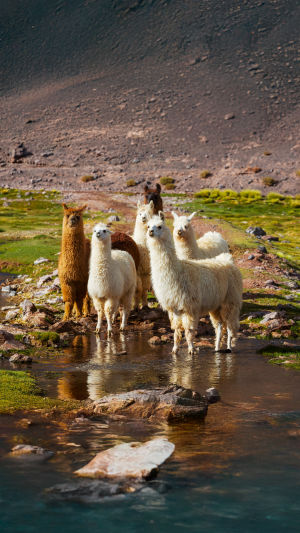You're sitting on a grassy hill, breathing in slowly, trying to calm a racing mind. Then an alpaca ambles over and plops down beside you—calm, fluffy, and oddly comforting. No judgment, no rush, just presence.
It's not a fantasy scene from a feel-good movie—it's real life at an increasing number of wellness retreats.
Alpacas, with their gentle personalities and soft features, are showing up everywhere from anxiety workshops to mindfulness retreats. But why alpacas? And do they really help people feel better—or are they just a cute?
Let's unpack what's actually happening between humans and these soft-eyed animals—and why wellness experts are increasingly building entire experiences around them.
<h3>Not Just Cute: Alpacas and Emotional Regulation</h3>
The real power of alpacas doesn't lie in how adorable they look (though that definitely helps). It's in how they affect our nervous system.
<b>1. Alpacas naturally invite calm.</b> According to Dr. Elizabeth Hartman, a clinical psychologist specializing in animal-assisted therapy, "Alpacas have a rhythmic, slow pace and an intuitive way of staying calm in new environments. Just being around them can influence human heart rate and breathing patterns."
That's not just observation—it's measurable. Studies in animal-assisted interventions (AAI) have shown that heart rate variability (HRV), a key marker of nervous system balance, improves when people interact with calm, non-threatening animals like alpacas or llamas. Increased HRV is linked to lower anxiety, better emotional control, and more stable moods.
<b>2. They reduce "performance pressure."</b> Unlike dogs, which often demand attention or respond to commands, alpacas are more passive. They walk gently, keep a soft gaze, and don't expect anything back. That's exactly why they're showing up in emotional healing spaces: people feel safe around them without needing to perform or please.
<h3>Why They Fit So Well in Retreat Settings</h3>
So, why are alpacas suddenly a popular feature at mindfulness workshops and weekend getaways?
<b>1. They slow people down—literally.</b> At the "Still Earth Retreat", facilitators often begin sessions with alpaca walks. But these aren't brisk nature hikes. "We tell guests: the alpaca sets the pace," says retreat organizer Gina Monroe. "That means slowing your breathing, matching their footsteps, staying in the moment."
<b>2. They give people something to focus on besides their own thoughts.</b> For people battling anxiety or intrusive thoughts, focusing inward can be overwhelming. The presence of an alpaca redirects that energy. Grooming, walking, or even just sitting near one provides a nonverbal grounding point, anchoring attention without forcing introspection.
<b>3. They naturally support social connection.</b> Strangers at wellness retreats often bond over shared activities—and alpacas serve as natural ice-breakers. Studies in Anthrozoös, a journal of human-animal interactions, found that animals increase group cohesion and feelings of safety in therapy environments.
<h3>Real-Life Use Cases: Who's Benefiting?</h3>
The emotional impact of alpacas isn't just theory. Here's how different groups are responding in practical ways:
1. Trauma survivors and anxiety sufferers
Retreats like The Mindful Herd in Vermont specialize in trauma-informed therapy with alpacas. Participants often report that the quiet presence of the animals helps them re-establish trust—not just in others, but in their own bodies and reactions.
2. Children and teens with sensory sensitivity
Alpacas have soft fleece, low vocalizations, and slow movements, making them especially well-suited for kids who find dogs too loud or unpredictable. One parent at a weekend therapy program, shared that her son, diagnosed with sensory processing disorder, "actually reached out and touched the alpaca first—something he never does with animals."
3. Burnout and workplace stress recovery
Corporate wellness events are even adding "alpaca breaks" to programs. One wellness company reports that attendees who spent 15 minutes with alpacas before sessions were more focused and less irritable, based on post-session surveys.
<h3>What Happens During an Alpaca Therapy Session?</h3>
Unlike more structured therapy, alpaca-assisted sessions are loose by design—but they still follow some intentional practices:
• Grounding introductions: Participants meet the herd, often guided through breathing exercises first
• Gentle interaction: Brushing, feeding, or walking the alpacas at their own pace
• Mindfulness moments: Facilitators invite reflection on what it feels like to be present with the animal
• Group processing (optional): Some retreats end sessions with group discussions or journaling
No experience with animals is needed, and safety is always a priority—handlers are present to guide both the animals and the people.
<h3>Not a Cure-All, But a Catalyst</h3>
Experts caution against viewing alpacas as magical fixers. "Alpaca-assisted therapy should be seen as one piece of a wellness toolkit," says Dr. Karen Mueller, an occupational therapist who has studied the emotional effects of human-animal interaction. "It's not a replacement for traditional therapy—but it's an incredible enhancer for people who struggle with emotional regulation or engagement."
And yes, they're Instagram-friendly. But behind the photos is something deeper: a reminder that healing isn't always about talking—it's often about slowing down, being present, and learning how to connect without words.
Have you ever been around alpacas—or would you want to try it? Whether you're burned out, anxious, or just curious, maybe it's time to ditch your screen for a day and walk beside something soft, quiet, and steady.
You might not get any advice from an alpaca—but you just might leave feeling lighter than when you arrived.





